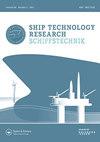A consistent method to design and evaluate the performance of Anti-Roll Tanks for ships
IF 0.9
Q3 ENGINEERING, MARINE
引用次数: 1
Abstract
ABSTRACT This article presents practical methods to design an Anti-Roll tank (ART) for a ship and to predict the performance of the system ship + ART in a sea state. The methods presented are extensions of existing mathematical models. The prediction of the moment exerted by the tanks has been improved and new models for the lateral force have been derived. Instead of using only the roll angle, a combination of the roll angle and the local lateral acceleration is used as excitation of the motion of the tank. The main advantage of this combined parameter is that it accounts for the distance of the tank bottom to the roll axis and the effect of sway. Experimental and CFD methods have been reviewed and results are shown. Limits of the use of the U and FS-type of ART are separately discussed and quantified. The procedure is demonstrated by a design example.一种设计和评估船舶减摇舱性能的一致性方法
摘要本文介绍了一种实用的船舶减摇舱(ART)设计方法,以及船舶+ART系统在海况下的性能预测方法。所提出的方法是对现有数学模型的扩展。改进了对坦克施加力矩的预测,并推导出了新的侧向力模型。不是仅使用滚转角,而是使用滚转角和局部横向加速度的组合作为坦克运动的激励。该组合参数的主要优点是,它考虑了罐底到滚动轴的距离和摇摆的影响。对实验和CFD方法进行了综述,并给出了结果。U型和FS型ART的使用限制分别进行了讨论和量化。该程序通过一个设计示例进行了演示。
本文章由计算机程序翻译,如有差异,请以英文原文为准。
求助全文
约1分钟内获得全文
求助全文

 求助内容:
求助内容: 应助结果提醒方式:
应助结果提醒方式:


